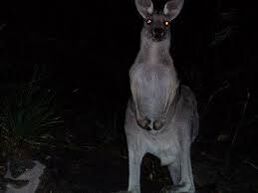
Photo from Chicago
Out-of-place, kangaroo-like MARSUPIAL seen in
North America and Europe far outside its normal
range.
Physical description: Height, 3–6 feet. Light tan
to brown in color. Pointed ears. Pointed snout.
Large hind legs and small forelegs. Long tail.
Behavior: Takes long jumps. Can move as fast
as 20 miles an hour.
Distribution: United States, especially in the
East and Midwest; southern Canada; England;
Moselle Department, France; Värmland
County, Sweden.
A partial list of North American places where
Phantom kangaroos have been reported follows:
California—San Francisco.
Colorado—Golden.
Delaware—Concord.
Illinois—Chicago, Dalton City, Du Quoin,
Evanston, Lansing, Plano, Rock Island.
Indiana—Carmel, Rensselaer, Sheridan.
Iowa—Ottumwa, Wellman.
Kansas—Abilene, Wakefield.
Michigan—Detroit, East Lansing.
Minnesota—Anoka, Coon Rapids.
Nebraska—Grand Island, Endicott, Fairbury,
Stanton.
New Brunswick, Canada—Milltown, Miramichi.
New York—Webster.
North Carolina—Asheville.
Nova Scotia, Canada—Bridgetown.
Ohio—Grove City, Monroe.
Oklahoma—Owasso, Tulsa.
Ontario, Canada—Scarborough.
Tennessee—Hamburg.
Utah—Cedar Fort.
Washington—Puyallup.
Wisconsin—Brookfield, Eau Claire County,
New Richmond, Pewaukee, Waukesha.
Significant sightings: During the New Richmond,
Wisconsin, tornado of June 12, 1899, a
kangaroo was seen running through a woman’s
backyard. Although a circus was in town, apparently
no kangaroos were accompanying it.
On January 13 and 14, 1934, a giant kangaroo
reportedly killed and ate some police dogs in
Hamburg, Tennessee. Rev. W. J. Hancock saw
it running and leaping across a field.
On July 28, 1958, Charles Wetzel saw a deerlike
animal chasing some dogs by his cabin on
the Platte River near Grand Island, Nebraska.
When he got within 10 yards of it, he realized it
was a kangaroo. It bounded away into an alfalfa
field, taking 10-foot leaps. Wetzel, who operated
a brewery, was so taken with the experience
that he named one of his beer brands “Wetzel
Kangaroo Beer.”
Chicago policemen Leonard Ciagi and
Michael Byrne encountered a 5-foot kangaroo
in the early morning of October 18, 1974, in a
dark alley on the northwest side of the city.
When Ciagi tried to handcuff it, the animal
kicked him hard in the legs before it escaped by
leaping over a fence.
After more than two weeks of mysterious
kangaroo sightings in the Waukesha, Wisconsin,
area, two men took a blurry Polaroid photograph
of a kangaroo they saw in the bush near
Pewaukee on April 24, 1978. Loren Coleman
says it resembles a Red-necked wallaby (Macropus
rufogriseus) or Swamp wallaby (Wallabia bicolor).
Years later, an unconfirmed story surfaced
that the two men were taxidermists who
had taken a photo of a stuffed wallaby.
In early June 1981, Ray Ault was tending
sheep near Cedar Fort, Utah, when he saw a big,
yellowish kangaroo jump past his herd.
On August 4, 1999, Lois Eckhardt saw a kangaroo-
like animal with a long tail on her cattle
farm near Wellman, Iowa.
In October 2000, there were four sightings of
a 6-foot kangaroo nibbling on leaves in Beckenham
Place Park, near Lewisham, London.
Possible explanations:
(1) Zoo escapees, such as a Kinkajou (Potos
flavus), Mara (Dolichotis spp.), Civet
(Viverrinae), or an actual Kangaroo (Family
Macropodidae), have been suggested as
candidates and occasionally caught.
(2) The raccoonlike White-nosed coati
(Nasua narica) often carries its long tail
erect as it runs, though it is seen more often
in bands rather than alone. Its range is
limited to Arizona, New Mexico, and
Mexico.